 Hyundai Accent: Using a child restraint system
Hyundai Accent: Using a child restraint system
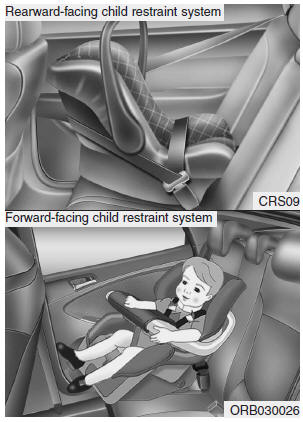
For small children and babies, the use of a child seat or infant seat is required. This child seat or infant seat should be of appropriate size for the child and should be installed in accordance with the manufacturer's instructions.
For safety reasons, we recommend that the child restraint system be used in the rear seats.
![]() WARNING
WARNING
Never place a rear-facing child restraint in the front passenger seat, because of the danger that an inflating passenger-side air bag could impact the rear-facing child restraint and kill the child.
Since all passenger seat belts move freely under normal conditions and only lock under extreme or emergency conditions (emergency locking mode), you must manually change these seat belts to the automatic locking mode to secure a child restraint.
![]() WARNING - Child seat installation
WARNING - Child seat installation
- A child can be seriously injured or killed in a collision if the child restraint is not properly anchored to the vehicle and the child is not properly restrained in the child restraint. Before installing the child restraint system, read the instructions supplied by the child restraint system manufacturer.
- If the seat belt does not operate as described in this section, have the system checked immediately by your authorized HYUNDAI dealer.
- Failure to observe this manual's instructions regarding child restraint systems and the instructions provided with the child restraint system could increase the chance and/or severity of injury in an accident.
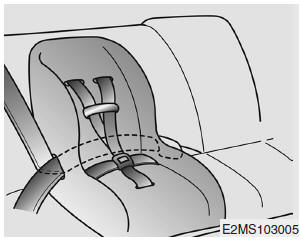
Placing a passenger seat belt into the automatic locking mode
The automatic locking mode will help prevent the normal movement of the child in the vehicle from causing the seat belt to loosen and compromise the child restraint system. To secure a child restraint system, use the following procedure.
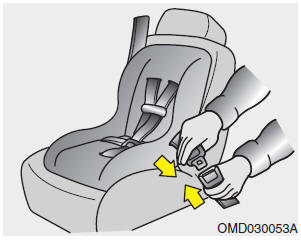
To install a child restraint system on the outboard or center rear seats, do the following:
1. Place the child restraint system in the seat and route the lap/shoulder belt
around or through the restraint, following the restraint manufacturerŌĆÖs instructions.
Be sure the seat belt webbing is not twisted.
2. Fasten the lap/shoulder belt latch into the buckle. Listen for the distinct ŌĆ£clickŌĆØ
sound.
Position the release button so that it is easy to access in case of an emergency.
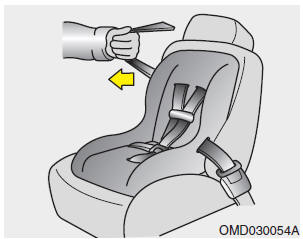
3. Pull the shoulder portion of the seat belt all the way out. When the shoulder portion of the seat belt is fully extended, it will shift the retractor to the ŌĆ£Automatic lockingŌĆØ (child restraint) mode.
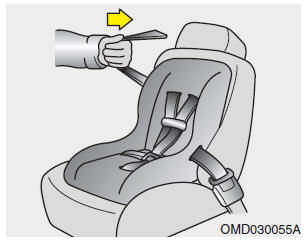
4. Slowly allow the shoulder portion of the seat belt to retract and listen for an audible ŌĆ£clickingŌĆØ or ŌĆ£ratchetingŌĆØ sound. This indicates that the retractor is in the ŌĆ£automatic lockingŌĆØ mode. If no distinct sound is heard, repeat steps 3 and 4.
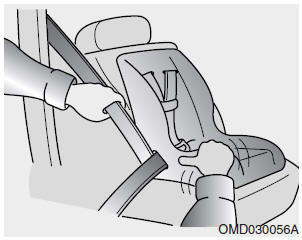
5. Remove as much slack from the belt as possible by pushing down on the child
restraint system while feeding the shoulder belt back into the retractor.
6. Push and pull on the child restraint system to confirm that the seat belt is
holding it firmly in place. If it is not, release the seat belt and repeat steps
2 through 6.
7. Double check that the retractor is in the ŌĆ£Automatic lockingŌĆØ mode by attempting
to pull more of the seat belt out of the retractor. If you cannot, the retractor
is in the ŌĆ£Automatic lockingŌĆØ mode.
To remove the child restraint, press the release button on the buckle and then pull the lap/shoulder belt out of the restraint and allow the seat belt to retract fully.
![]() WARNING - Automatic locking mode
WARNING - Automatic locking mode
The lap/shoulder belt automatically returns to the ŌĆ£emergency lock modeŌĆØ whenever the belt is allowed to retract fully. Therefore, the preceding seven steps must be followed each time a child restraint is installed.
If the retractor is not in the Automatic Locking mode, the child restraint can move when your vehicle turns or stops suddenly. A child can be seriously injured or killed if the child restraint is not properly anchored to the car, including setting the retractor to the Automatic Locking mode.
When the seat belt is allowed to retract to its fully stowed position, the retractor will automatically switch from the ŌĆ£Automatic lockingŌĆØ mode to the emergency lock mode for normal adult usage.
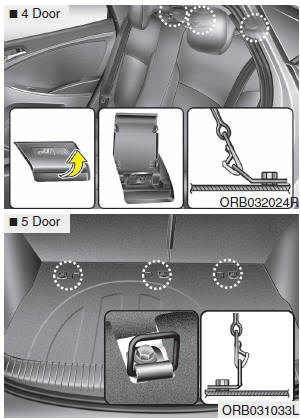
Securing a child restraint seat with ŌĆ£Tether AnchorŌĆØ system
Child restraint hook holders are located on the package tray or on the floor behind the rear seats.
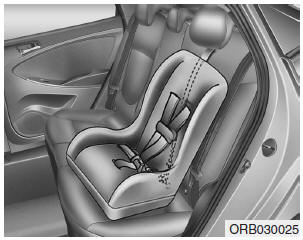
1. Route the child restraint seat strap over the seatback.
For vehicles with adjustable headrests, route the tether strap under the headrest and between the headrest posts, otherwise route the tether strap over the top of the seatback.
2. Connect the tether strap hook to the appropriate child restraint hook holder and tighten to secure the child restraint seat.
![]() WARNING
WARNING
A child can be seriously injured or killed in a collision if the child restraint is not properly anchored to the car and the child is not properly restrained in the child restraint. Always follow the child seat manufacturerŌĆÖs instructions for installation and use.
![]() WARNING - Tether strap
WARNING - Tether strap
Never mount more than one child restraint to a single tether anchor or to a single lower anchorage point. The increased load caused by multiple seats may cause the tethers or anchorage points to break, causing serious injury or death.
![]() WARNING - Child restraint check
WARNING - Child restraint check
Check that the child restraint system is secure by pushing and pulling it in different directions. Incorrectly fitted child restraints may swing, twist, tip or separate causing death or serious injury.
![]() WARNING - Child restraint anchorage
WARNING - Child restraint anchorage
- Child restraint anchorages are designed to withstand only those loads imposed by correctly fitted child restraints. Under no circumstances are they to be used for adult seat belts or harnesses or for attaching other items or equipment to the vehicle.
- The tether strap may not work properly if attached somewhere other than the correct tether anchor.
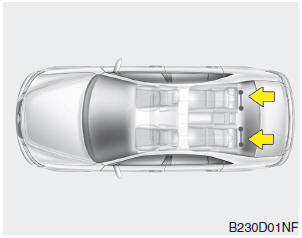
Securing a child restraint seat with child seat lower anchor system
Some child seat manufacturers make child restraint seats that are labeled as LATCH or LATCH-compatible child restraint seats. LATCH stands for "Lower Anchors and Tethers for Children". These seats include two rigid or webbing mounted attachments that connect to two LATCH anchors at specific seating positions in your vehicle. This type of child restraint seat eliminates the need to use seat belts to attach the child seat in the rear seats.
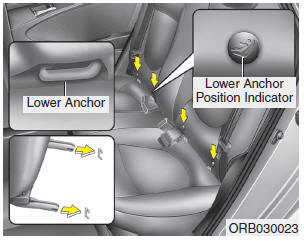
Child restraint symbols are located on the left and right rear seat backs to indicate the position of the lower anchors for child restraints.
![]() WARNING
WARNING
- When using the vehicle's "LATCH" system to install a child restraint system in the rear seat, all unused vehicle rear seat belt metal latch plates or tabs must be latched securely in their seat belt buckles and the seat belt webbing must be retracted behind the child restraint to prevent the child from reaching and taking hold of unretracted seat belts. Unlatched metal latch plates or tabs may allow the child to reach the unretracted seat belts which may result in strangulation and a serious injury or death to the child in the child restraint.
- Do not place anything around the lower anchors. Also make sure that the seat belt is not caught in the lower anchors.
LATCH anchors have been provided in your vehicle. The LATCH anchors are located in the left and right outboard rear seating positions. Their locations are shown in the illustration. There is no LATCH anchor provided for the center rear seating position.
The LATCH anchors are located between the seatback and the seat cushion of the rear seat left and right outboard seating positions.
Follow the child seat manufacturerŌĆÖs instructions to properly install child restraint seats with LATCH or LATCHcompatible attachments.
Once you have installed the LATCH child restraint, assure that the seat is properly attached to the LATCH and tether anchors.
Also, test the child restraint seat before you place the child in it. Tilt the seat from side to side. Also try to tug the seat forward. Check to see if the anchors hold the seat in place.
![]() CAUTION
CAUTION
Do not allow the rear seat belt webbing to get scratched or pinched by the child-seat latch and LATCH anchor during the installation.
![]() WARNING
WARNING
If the child restraint is not anchored properly, the risk of a child being seriously injured or killed in a collision greatly increases.
![]() WARNING - LATCH lower anchors
WARNING - LATCH lower anchors
LATCH lower anchors are only to be used with the left and right rear outboard seating positions. Never attempt to attach a LATCH equipped seat in the center seating position. You may damage the anchors or the anchors may fail and break in a collision.
 Child restraint system
Child restraint system
Children riding in the car should sit in the rear seat and must always be properly
restrained to minimize the risk of injury in an accident, sudden stop or sudden
maneuver. According to accident s ...
 Air bag - advanced supplemental restraint system
Air bag - advanced supplemental restraint system
(1) DriverŌĆÖs front air bag
(2) PassengerŌĆÖs front air bag
(3) Side impact air bag
(4) Curtain air bag
WARNING
Even in vehicles with air bags, you and your passengers must always wear
the ...
See also:
California perchlorate notice
Perchlorate Material-special handling may apply, See www.dtsc.ca.gov/hazardouswaste/
perchlorate.
Notice to California Vehicle Dismantlers: Perchlorate containing materials, such
as air bag infla ...
ECM Terminal And Input/Output signal [A/T]
ECM Terminal Function
(A/T)
Connector [EGGA-AG]
Pin No.
Description
Connected to
1
Injector (Cylinder #1) [High] ...
Measurement Point
Measurements should be taken at the center of the hole.
...
Hyundai Accent Manuals
- Hyundai Accent 2017-2022 Service Manual
- Hyundai Accent 2010-2025 Owners Manual
- Hyundai Accent 2010-2025 Service Manual
